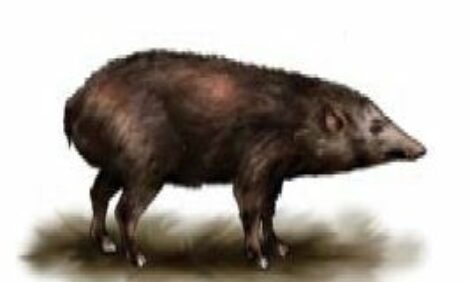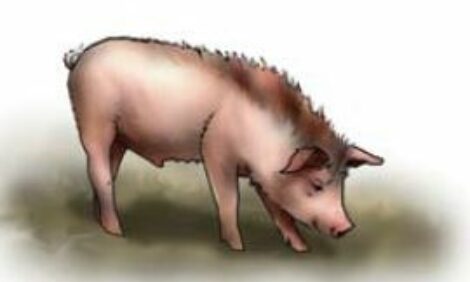



Turopolje
The Turopolje pig (Croatian: Turopoljska svinja) is a breed of pig named for Turopolje, Croatia, where it originates. The Turopolje has off-white curly hair, with black patches on either side of the body. They have white skin, a long body, and a head of average length with a concave profile. Their ears are partially protruding, and do not cover the eyes. They have a very flat, straight back. They are not particularly fertile, having five piglets per brood, and a 69% weaning rate on average. They have a high level of resistance to disease, and a high level of adaptability to marshland, being remarkably well able to withstand changes in climate and bad weather.
The Turopolje pig is without doubt the oldest in Croatia and can be considered one of the oldest in Europe. It came into being in the Turopolje region which is situated between the Kupa and Sava rivers east of Zagreb. The domesticated animal was the "peatland pig" reared by the inhabitants of the upper reaches of the Sava river who lived in houses on stilts. From this domestic breed was developed the ideal production form, the Krskopoljski pig. During the pre-historical period and antiquity, the Krskopoljski pig spread to the Turopolje region. This is thought to have become the Siska breed, which subsequently spread throughout the entire Balkan peninsula. It is also believed that the Turopolje pig resulted from crossing the Siska breed with the Krskopoljski from neighbouring Slovenia.
The Turopolje pig adapted itself perfectly to the ecosystem, using the extensive oak woodlands as an important source of food. This specific diet contributed to the success of this breed, which was fed mainly in woodlands on acorns and, just prior to slaughter, on maize. The pigs found protein by eating the worms and larvae they found in the woods. The pigs were slaughtered either at home or in the woods. A successful year depended heavily on the food available in the forests they roamed in; in a good year the pigs were ready for slaughter when they came from the woods and only a small amount of maize was needed.
Sows from 2-4 years old were slaughtered along with castrated males more than one-year-old. When the pigs came from the woods they were fed one kilo of maize per day with plenty of clean water in order to clean the digestive tract for slaughter. After a few days the maize was gradually increased to five kilos per day. The fattened pigs would weigh from 170-220 kilos. The Turopolje pig has been eclipsed by the advance of white pigs which are better adapted to market requirements. During the last fifty years its numbers have been drastically reduced, and it is thought almost to the point of extinction. Though it is relatively small and not fast growing, the breed is known for its hardiness under free range conditions. Once one of the most widespread swine in its native country, the change from extensive to intensive pig farming in the mid-20th century discouraged its use.








